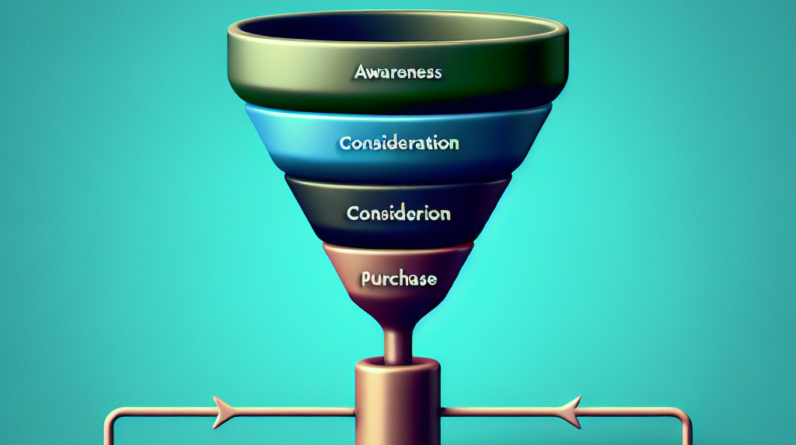
Creating advertising campaigns for different stages of the sales funnel can seem like a daunting task, but fear not! This article is here to guide you through the process with a friendly and helpful approach. From raising awareness and generating interest to nurturing leads and closing deals, we’ll explore effective strategies to engage and convert your target audience at every stage of their customer journey. So, whether you’re a seasoned marketer or just starting out, get ready to unlock the secrets of crafting compelling campaigns that drive results.
Understanding the Sales Funnel
What is a sales funnel?
A sales funnel is a visual representation of the customer journey from the moment they become aware of your brand to the point of purchase. It illustrates the process through which potential customers become actual customers. The funnel comprises several stages that customers go through, starting from the top down to the bottom. Each stage represents a different level of engagement and interaction with your brand.
Why is the sales funnel important?
Understanding the sales funnel is crucial for businesses because it allows them to effectively guide potential customers towards making a purchase. By mapping out the customer journey, businesses can identify areas where potential customers might drop off or lose interest, and implement strategies to keep them engaged. The sales funnel helps businesses optimize their marketing efforts, tailor their messaging, and ultimately increase conversions and sales.
Different stages of the sales funnel
The sales funnel consists of three main stages: the top of the funnel (TOFU), the middle of the funnel (MOFU), and the bottom of the funnel (BOFU).
Identifying Target Audience
Segmenting your target audience
To effectively reach your target audience, it is important to segment them into different groups based on various characteristics such as demographics, behaviors, and preferences. Segmentation allows businesses to tailor their marketing messages and strategies to suit the specific needs and interests of each segment.
Understanding customer personas
Customer personas are fictional representations of your ideal customers. They are created based on data and research, and help businesses understand the motivations, goals, and challenges of their target audience. By developing detailed customer personas, businesses can better customize their advertising campaigns and create content that resonates with their ideal customers.
Analyzing customer behavior
Analyzing customer behavior involves collecting and analyzing data on how customers interact with your brand, products, and advertisements. This data can provide insights into customer preferences, purchasing patterns, and decision-making processes. By analyzing customer behavior, businesses can identify opportunities for improvement and tailor their advertising campaigns to align with customer expectations.

Top of the Funnel (TOFU)
Introduction to TOFU
The top of the funnel (TOFU) is the initial stage of the sales funnel where potential customers become aware of your brand. At this stage, customers may not yet have a clear understanding of their problem or the solution they need. The goal is to capture their attention and create brand awareness.
Creating brand awareness
Creating brand awareness is crucial at the top of the funnel. This can be achieved through various marketing strategies such as advertising, public relations, and social media. By creating compelling and memorable brand experiences, businesses can capture the attention of potential customers and make a lasting impression.
Content marketing strategies
Content marketing plays a significant role in the top of the funnel. By creating valuable and informative content, businesses can attract and engage potential customers. This can include blog posts, videos, infographics, and other forms of content that provide valuable information and position your brand as a trusted resource.
Utilizing social media
Social media platforms offer a powerful tool for reaching potential customers at the top of the funnel. By utilizing social media advertising and engagement strategies, businesses can target specific demographics and interests, thus increasing brand visibility and awareness.
Implementing SEO tactics
Search engine optimization (SEO) is essential for increasing organic visibility and driving traffic to your website. By optimizing your website and content for relevant keywords and improving your search engine rankings, you can attract potential customers searching for solutions related to your products or services.
Middle of the Funnel (MOFU)
Introduction to MOFU
The middle of the funnel (MOFU) is the stage where potential customers have shown interest in your brand and are exploring their options. At this stage, they are comparing different solutions and evaluating their potential benefits.
Generating and nurturing leads
Generating and nurturing leads is a crucial aspect of the middle of the funnel. Businesses can capture leads through lead generation forms, subscription sign-ups, or other means of gathering contact information. Once leads are obtained, nurturing them with relevant and personalized content can help guide them closer to making a purchase.
Using lead magnets
Lead magnets are valuable resources offered to potential customers in exchange for their contact information. These can include free e-books, webinars, templates, or other resources that provide value and help potential customers in their decision-making process.
Email marketing campaigns
Email marketing campaigns are effective in nurturing leads and guiding them through the middle of the funnel. By delivering personalized and relevant content directly to their inbox, businesses can maintain engagement and build trust with potential customers.
Retargeting strategies
Retargeting involves showing ads to potential customers who have already interacted with your brand or website. This strategy keeps your brand top of mind and encourages them to revisit your website or take further action.
Providing educational content
Offering educational content to potential customers is essential in the middle of the funnel. This can include tutorials, case studies, product demos, or other resources that showcase the benefits and features of your products or services. By providing valuable information, businesses can demonstrate expertise, build trust, and influence potential customers’ purchase decisions.

Bottom of the Funnel (BOFU)
Introduction to BOFU
The bottom of the funnel (BOFU) is the final stage where potential customers are ready to make a purchasing decision. At this point, they have narrowed down their options and are evaluating the best solution for their needs.
Driving conversions and sales
The primary goal at the bottom of the funnel is to drive conversions and sales. Businesses should focus on delivering persuasive messaging and offers that encourage potential customers to take that final step and make a purchase.
Remarketing techniques
Remarketing involves targeting individuals who have previously interacted with your brand or website with specialized ads. These ads can offer incentives, discounts, or other incentives to entice potential customers to convert.
Offering personalized experiences
Personalized experiences can significantly impact potential customers’ decision-making process at the bottom of the funnel. By tailoring offers and messaging to their specific needs and preferences, businesses can create a sense of value and urgency that can lead to conversions.
Implementing email automation
Email automation allows businesses to deliver personalized and timely content to potential customers at the right stage of their journey. By automating email sequences and workflows, businesses can nurture leads, address objections, and provide the necessary information needed to guide potential customers towards making a purchase.
Providing testimonials and case studies
Testimonials and case studies provide social proof and reassurance to potential customers who are in the final stages of their decision-making process. By showcasing positive experiences and successful outcomes from previous customers, businesses can build trust and alleviate any doubts or hesitations.
Reducing barriers to purchase
At the bottom of the funnel, it is crucial to analyze and address any barriers or obstacles that may prevent potential customers from completing their purchase. This can include simplifying the checkout process, offering flexible payment options, or providing excellent customer support to address any concerns.
Aligning Content and Messaging
Consistency across the funnel
Maintaining consistency across the funnel is essential for creating a seamless customer journey. It is crucial to align your brand messaging, tone of voice, and visual identity to ensure a cohesive experience from the top down to the bottom of the funnel.
Tailoring content for each stage
To effectively engage potential customers at each stage of the funnel, businesses must tailor their content to address their specific needs and interests. Content should be relevant, informative, and provide value based on the stage of the customer’s journey.
Aligning messaging with customer needs
Understanding your target audience and their pain points is key to aligning your messaging with their needs. By addressing their challenges and offering solutions, businesses can position themselves as valuable partners in their decision-making process.
Creating compelling calls-to-action
Calls-to-action (CTAs) are crucial elements of any advertising campaign. They encourage potential customers to take the desired action, whether it’s signing up for a newsletter, downloading a resource, or making a purchase. CTAs should be clear, compelling, and tailored to the specific stage of the funnel.
Measuring and Analyzing Campaigns
Defining key performance indicators (KPIs)
Defining relevant key performance indicators (KPIs) is crucial for assessing the effectiveness and success of your advertising campaigns. KPIs can include metrics such as conversion rates, click-through rates, cost per conversion, and return on investment (ROI).
Implementing tracking and analytics
Tracking and analytics tools provide valuable insights into the performance of your advertising campaigns. By monitoring data such as website traffic, audience demographics, and engagement rates, businesses can make data-driven decisions and optimize their campaigns accordingly.
A/B testing for optimization
A/B testing involves comparing two versions of an advertising campaign to determine which performs better. By testing different elements such as headlines, images, or CTAs, businesses can identify what resonates best with their target audience and optimize their campaigns for maximum effectiveness.
Analyzing customer journey
Analyzing the customer journey involves mapping out the touchpoints and interactions potential customers have with your brand. By understanding their behaviors, preferences, and pain points at each stage, businesses can optimize their campaigns to better guide potential customers towards conversion.
Optimizing campaigns based on data
Data-driven optimization is key to improving the effectiveness of your advertising campaigns. By analyzing performance data and making data-driven decisions, businesses can refine their targeting, messaging, and strategies to achieve better results and higher conversions.
Continuous Optimization and Iteration
Evaluating campaign performance
Regularly evaluating campaign performance is essential for continuous improvement. By analyzing and tracking key metrics, businesses can identify areas of success and areas that need improvement. This allows them to make necessary adjustments to their campaigns to increase effectiveness and results.
Identifying areas for improvement
Identifying areas for improvement involves analyzing data, customer feedback, and industry trends to identify areas of weakness or opportunities. By recognizing areas that need improvement, businesses can implement strategies to address gaps and refine their advertising campaigns.
Testing and tweaking strategies
Effective advertising campaigns require ongoing testing and tweaking to ensure optimal results. By continually experimenting with different strategies, messaging, and targeting, businesses can identify what works best and continuously improve their campaigns.
Adapting to changing market trends
The advertising landscape is constantly evolving, and businesses must adapt to changing market trends to stay relevant. By staying updated on industry trends, consumer preferences, and emerging technologies, businesses can make informed decisions and adjust their advertising strategies accordingly.
Monitoring competitor tactics
Monitoring competitor tactics is crucial for staying competitive and identifying opportunities for improvement. By keeping an eye on what your competitors are doing, businesses can learn from their successes and failures and make adjustments to their own advertising campaigns.
Integrating Offline and Online Advertising
Leveraging traditional advertising channels
While online advertising has become increasingly popular, traditional advertising channels still play a significant role in reaching potential customers. By combining offline and online advertising strategies, businesses can effectively reach a wider audience and create a cohesive brand experience.
Cross-channel marketing strategies
Cross-channel marketing involves integrating multiple marketing channels to deliver a unified brand experience. By leveraging various channels such as social media, email marketing, print advertising, and events, businesses can engage potential customers through different touchpoints and reinforce their messaging.
Tracking offline conversions
Tracking offline conversions can be challenging, but it is essential for evaluating the effectiveness of offline advertising campaigns. This can be achieved through tactics such as unique coupon codes, QR codes, dedicated phone numbers, or customer surveys. By tracking offline conversions, businesses can measure the impact of their offline advertising efforts and make data-driven decisions.
Creating cohesive brand experiences
Integrating offline and online advertising allows businesses to create cohesive brand experiences that resonate with potential customers. Consistency in messaging, visuals, and overall brand identity across different channels helps build brand recognition and trust, ultimately driving conversions and sales.
Conclusion
Understanding the sales funnel is crucial for businesses looking to create effective advertising campaigns. By identifying their target audience, mapping out the customer journey, and aligning their content and messaging, businesses can guide potential customers towards making a purchase. Measuring, analyzing, and continuously optimizing campaigns, along with integrating offline and online advertising, ensures businesses stay competitive in an ever-evolving marketing landscape. By following these strategies and approaches, businesses can create advertising campaigns that drive results and effectively nurture potential customers through each stage of the sales funnel.





